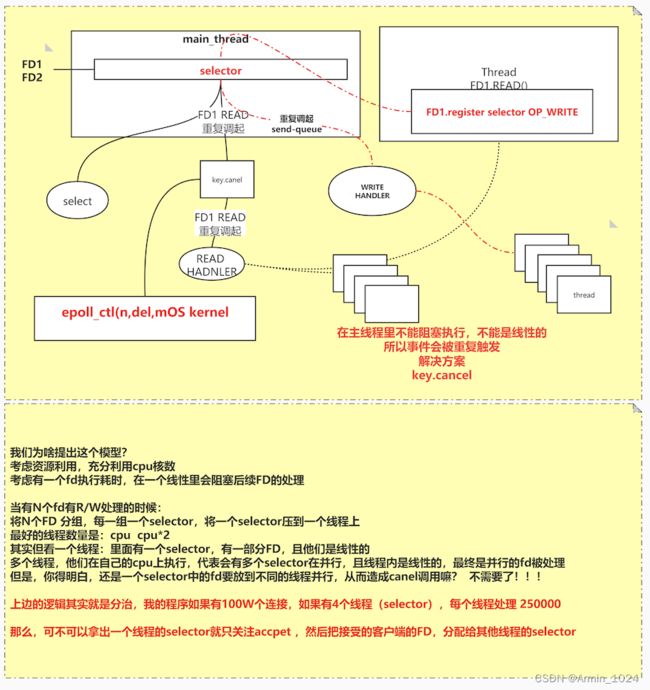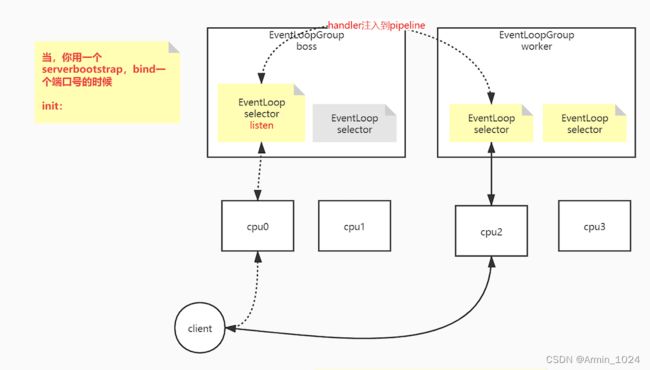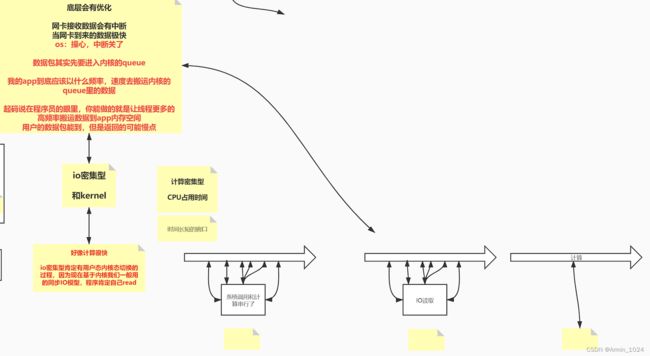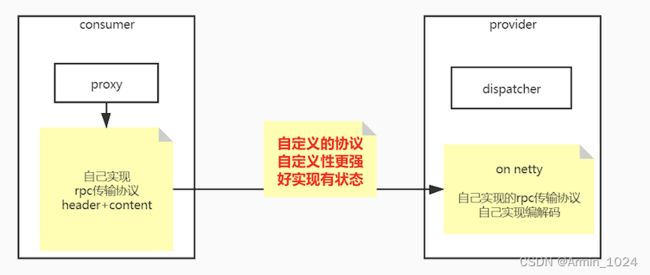IO原理与JAVA RPC
Linux IO
文件分区
# 不同的文件系统挂载到不同的目录下,如下/dev挂载点,取消/dev的挂载后,如存在dev文件则仍可见dev
[root@VM-16-13-centos ~]# df
文件系统 1K-块 已用 可用 已用% 挂载点
devtmpfs 1896680 0 1896680 0% /dev
tmpfs 1912948 24 1912924 1% /dev/shm
tmpfs 1912948 484 1912464 1% /run
tmpfs 1912948 0 1912948 0% /sys/fs/cgroup
/dev/vda1 82503044 8552896 70494644 11% /
tmpfs 382588 0 382588 0% /run/user/0
# 查看不同挂载点分配的空间详情
[root@VM-16-13-centos /]# df -h
文件系统 容量 已用 可用 已用% 挂载点
devtmpfs 1.9G 0 1.9G 0% /dev
tmpfs 1.9G 24K 1.9G 1% /dev/shm
tmpfs 1.9G 492K 1.9G 1% /run
tmpfs 1.9G 0 1.9G 0% /sys/fs/cgroup
/dev/vda1 79G 8.2G 68G 11% /
tmpfs 374M 0 374M 0% /run/user/0
# 卸载挂载目录
umount [挂载点目录]
# 挂载目录
mount [被挂载的分区镜像的位置] [挂载点目录]
硬链接(如同一份副本)
# root 目录下有一文件 a.txt
# 将 a.txt 文件硬链接到 b.txt
ln /root/a.txt /root/b.txt
# stat 查看Inode节点都是同一份
[root@VM-16-13-centos ~]# stat a.txt
文件:a.txt
大小:13 块:8 IO 块:4096 普通文件
设备:fd01h/64769d Inode:397618 硬链接:2
权限:(0644/-rw-r--r--) Uid:( 0/ root) Gid:( 0/ root)
最近访问:2022-04-19 21:04:52.485540981 +0800
最近更改:2022-04-19 21:04:50.707541495 +0800
最近改动:2022-04-19 21:05:07.032536783 +0800
创建时间:-
[root@VM-16-13-centos ~]# stat b.txt
文件:b.txt
大小:13 块:8 IO 块:4096 普通文件
设备:fd01h/64769d Inode:397618 硬链接:2
权限:(0644/-rw-r--r--) Uid:( 0/ root) Gid:( 0/ root)
最近访问:2022-04-19 21:04:52.485540981 +0800
最近更改:2022-04-19 21:04:50.707541495 +0800
最近改动:2022-04-19 21:05:07.032536783 +0800
创建时间:-
# 硬链接了几份文件就是几,这里有两份a.txt与b.txt
[root@VM-16-13-centos ~]# ll
总用量 8
-rw-r--r-- 2 root root 13 4月 19 21:04 a.txt
-rw-r--r-- 2 root root 13 4月 19 21:04 b.txt
# 任意编辑其中一文件另外被被链接的文件均会被修改
# 当删除a.txt或b.txt另一文件会继续存在,并且链接number会-1
[root@VM-16-13-centos ~]# ll
总用量 8
-rw-r--r-- 2 root root 13 4月 19 21:04 a.txt
-rw-r--r-- 2 root root 13 4月 19 21:04 b.txt
[root@VM-16-13-centos ~]# rm -rf a.txt
[root@VM-16-13-centos ~]# ll
总用量 4
-rw-r--r-- 1 root root 13 4月 19 21:04 b.txt
软链接(如同被链接文件的快捷方式)
# 将b.txt文件软链接到c.txt
ln -s /root/b.txt /root/c.txt
[root@VM-16-13-centos ~]# ln -s /root/b.txt /root/c.txt
[root@VM-16-13-centos ~]# ll
总用量 4
-rw-r--r-- 1 root root 13 4月 19 21:04 b.txt
lrwxrwxrwx 1 root root 11 4月 19 21:13 c.txt -> /root/b.txt
# 从上发现链接number不变都为1,查看器Inode节点不在同一结点
[root@VM-16-13-centos ~]# stat b.txt
文件:b.txt
大小:13 块:8 IO 块:4096 普通文件
设备:fd01h/64769d Inode:397618 硬链接:1
权限:(0644/-rw-r--r--) Uid:( 0/ root) Gid:( 0/ root)
最近访问:2022-04-19 21:04:52.485540981 +0800
最近更改:2022-04-19 21:04:50.707541495 +0800
最近改动:2022-04-19 21:12:37.980406709 +0800
创建时间:-
[root@VM-16-13-centos ~]# stat c.txt
文件:c.txt -> /root/b.txt
大小:11 块:0 IO 块:4096 符号链接
设备:fd01h/64769d Inode:398017 硬链接:1
权限:(0777/lrwxrwxrwx) Uid:( 0/ root) Gid:( 0/ root)
最近访问:2022-04-19 21:14:09.788380231 +0800
最近更改:2022-04-19 21:13:26.575392695 +0800
最近改动:2022-04-19 21:13:26.575392695 +0800
创建时间:-
# 编辑任意文件b.txt或c.txt其链接的文件都会改变
# 当删除被链接的文件b.txt则c.txt文件会显示异常无法操作
[root@VM-16-13-centos ~]# rm -rf b.txt
[root@VM-16-13-centos ~]# ll
总用量 0
lrwxrwxrwx 1 root root 11 4月 19 21:13 c.txt -> /root/b.txt (此处会显示为红色并闪烁,代表该文件不存在)
创建虚拟分区挂载
dd:拷贝数据生成文件if:输入文件(input file)/dev/zero:无限大的空of:输出文件(output file)bs:文件块大小(block size)count:块的数量
[root@VM-16-13-centos armin]# dd if=/dev/zero of=mydisk bs=1048576 count=10
记录了10+0 的读入
记录了10+0 的写出
10485760 bytes (10 MB, 10 MiB) copied, 0.00874465 s, 1.2 GB/s
[root@VM-16-13-centos armin]# ll
总用量 10240
-rw-r--r-- 1 root root 10485760 4月 19 22:16 mydisk
[root@VM-16-13-centos armin]# ll -h
总用量 10M
-rw-r--r-- 1 root root 10M 4月 19 22:16 mydisk
# 将 mydisk 挂载到 /dev/loop0 文件系统,并格式化为 ext2 格式
[root@VM-16-13-centos armin]# losetup /dev/loop0 mydisk
[root@VM-16-13-centos armin]# mke2fs /dev/loop0
mke2fs 1.45.6 (20-Mar-2020)
丢弃设备块: 完成
创建含有 10240 个块(每块 1k)和 2560 个inode的文件系统
文件系统UUID:7c626cc6-3e03-427e-b709-170e207dcbd8
超级块的备份存储于下列块:
8193
正在分配组表: 完成
正在写入inode表: 完成
写入超级块和文件系统账户统计信息: 已完成
# 将生成的文件系统挂载到 /mnt/ooxx目录
[root@VM-16-13-centos ooxx]# mount -t ext2 /dev/loop0 /mnt/ooxx/
[root@VM-16-13-centos ooxx]# df
文件系统 1K-块 已用 可用 已用% 挂载点
devtmpfs 1896680 0 1896680 0% /dev
tmpfs 1912948 24 1912924 1% /dev/shm
tmpfs 1912948 512 1912436 1% /run
tmpfs 1912948 0 1912948 0% /sys/fs/cgroup
/dev/vda1 82503044 8555436 70492104 11% /
tmpfs 382588 0 382588 0% /run/user/0
/dev/loop0 9911 92 9307 1% /mnt/ooxx
# 找到 bash(linux输入字符解析工具) 程序
[root@VM-16-13-centos ooxx]# whereis bash
bash: /usr/bin/bash /usr/share/man/man1/bash.1.gz /usr/share/info/bash.info.gz
# 将 bash 程序 copy 到 /mnt/ooxx/bin
[root@VM-16-13-centos ooxx]# mkdir bin
[root@VM-16-13-centos ooxx]# cp /usr/bin/bash bin
[root@VM-16-13-centos ooxx]# cd bin/
[root@VM-16-13-centos bin]# ll
总用量 1130
-rwxr-xr-x 1 root root 1150584 4月 19 22:33 bash
# 分析 bash 程序依赖的动态链接库
[root@VM-16-13-centos bin]# ldd bash
linux-vdso.so.1 (0x00007ffc09544000)
libtinfo.so.6 => /lib64/libtinfo.so.6 (0x00007f67444ec000)
libdl.so.2 => /lib64/libdl.so.2 (0x00007f67442e8000)
libc.so.6 => /lib64/libc.so.6 (0x00007f6743f23000)
/lib64/ld-linux-x86-64.so.2 (0x00007f6744a37000)
# 模拟 bash 程序copy依赖的动态链接库到 /mnt/ooxx 目录,{}当前目录中的多个文件可使用
[root@VM-16-13-centos ooxx]# mkdir lib64
[root@VM-16-13-centos ooxx]# cp /lib64/{libtinfo.so.6,libdl.so.2,libc.so.6,ld-linux-x86-64.so.2} ./lib64/
[root@VM-16-13-centos ooxx]# ll
总用量 1131
-rwxr-xr-x 1 root root 1150584 4月 19 22:33 bash
drwxr-xr-x 2 root root 1024 4月 19 22:37 lib64
[root@VM-16-13-centos ooxx]# cd lib64/
[root@VM-16-13-centos lib64]# ll
总用量 3598
-rwxr-xr-x 1 root root 278504 4月 19 22:37 ld-linux-x86-64.so.2
-rwxr-xr-x 1 root root 3167976 4月 19 22:37 libc.so.6
-rwxr-xr-x 1 root root 28816 4月 19 22:37 libdl.so.2
-rwxr-xr-x 1 root root 187496 4月 19 22:37 libtinfo.so.6
# 把根目录切换到当前目录,并启动当前目录 bash,获取当前进程id号
[root@VM-16-13-centos ooxx]# chroot ./
bash-4.4# echo $$
1318231
# 将111输出到虚拟文件系统根目录下a.txt文件
bash-4.4# echo 111 > /a.txt
# 父 bash 进程号
bash-4.4# exit
exit
[root@VM-16-13-centos ooxx]# echo $$
1314500
# 查看虚拟文件系统根目录是否存在 a.txt文件(存在)
-rw-r--r-- 1 root root 4 4月 19 22:46 a.txt
drwxr-xr-x 2 root root 1024 4月 19 22:41 bin
drwxr-xr-x 2 root root 1024 4月 19 22:37 lib64
drwx------ 2 root root 12288 4月 19 22:23 lost+found
[root@VM-16-13-centos ooxx]# cat a.txt
111
脏读
# lost 查看进程打开了哪些文件 $$代表当前bash进程
[root@VM-16-13-centos /]# lsof -p $$
COMMAND PID USER FD TYPE DEVICE SIZE/OFF NODE NAME
bash 1514926 root cwd DIR 253,1 4096 2 /
bash 1514926 root rtd DIR 253,1 4096 2 /
bash 1514926 root txt REG 253,1 1150584 268773 /usr/bin/bash
bash 1514926 root mem REG 253,1 83728 268316 /usr/lib64/libnss_files-2.28.so
bash 1514926 root mem REG 253,1 9253600 394534 /var/lib/sss/mc/passwd
bash 1514926 root mem REG 253,1 2801698 267884 /usr/lib/locale/zh_CN.utf8/LC_COLLATE
bash 1514926 root mem REG 253,1 3167976 268071 /usr/lib64/libc-2.28.so
bash 1514926 root 0u CHR 136,0 0t0 3 /dev/pts/0
bash 1514926 root 1u CHR 136,0 0t0 3 /dev/pts/0
bash 1514926 root 2u CHR 136,0 0t0 3 /dev/pts/0
bash 1514926 root 3r REG 253,1 9253600 394534 /var/lib/sss/mc/passwd
bash 1514926 root 4u unix 0xffff968df7c5ad00 0t0 33848491 type=STREAM
bash 1514926 root 255u CHR 136,0 0t0 3 /dev/pts/0
FD
- cwd:当前工作目录
- rtd:root根目录在哪
- txt:文本域,进程启动时加载的可执行程序
- mem:分配的内存空间
- xu(u:读写都可以、r:读)
- x=0:程序的标准输入
- x=1:程序的标准输出
- x=2:程序报错输出
TYPE
- REG:-(普通文件:可执行、图片、文本)
- CHR:c(字符设备)
- DIR:d(文件目录)
DEVICE
- 设备号
SIZE/OFF
- 偏移量
NODE
- Inode号
# 令文件描述符 8 可以去读取 xxoo.txt 文件
[root@VM-16-13-centos ~]# vi xxoo.txt
[root@VM-16-13-centos ~]# exec 8< xxoo.txt
[root@VM-16-13-centos ~]# cd /proc/$$/fd
[root@VM-16-13-centos fd]# ll
总用量 0
lrwx------ 1 root root 64 4月 20 22:35 0 -> /dev/pts/0
lrwx------ 1 root root 64 4月 20 22:35 1 -> /dev/pts/0
lrwx------ 1 root root 64 4月 20 22:35 2 -> /dev/pts/0
lrwx------ 1 root root 64 4月 20 22:36 255 -> /dev/pts/0
lr-x------ 1 root root 64 4月 20 22:35 3 -> /var/lib/sss/mc/passwd
lrwx------ 1 root root 64 4月 20 22:35 4 -> 'socket:[33848491]'
lr-x------ 1 root root 64 4月 20 22:35 8 -> /root/xxoo.txt
# 8r 8文件描述符读取 偏移量 0t0 为 0字节
[root@VM-16-13-centos fd]# lsof -op $$
COMMAND PID USER FD TYPE DEVICE OFFSET NODE NAME
bash 1514926 root cwd DIR 0,5 33848475 /proc/1514926/fd
bash 1514926 root rtd DIR 253,1 2 /
bash 1514926 root txt REG 253,1 268773 /usr/bin/bash
bash 1514926 root mem REG 253,1 267823 /usr/lib/locale/en_US.utf8/LC_COLLATE
bash 1514926 root mem REG 253,1 268316 /usr/lib64/libnss_files-2.28.so
bash 1514926 root mem REG 253,1 394534 /var/lib/sss/mc/passwd
bash 1514926 root mem REG 253,1 280182 /usr/lib64/libnss_sss.so.2
bash 1514926 root 0u CHR 136,0 0t0 3 /dev/pts/0
bash 1514926 root 1u CHR 136,0 0t0 3 /dev/pts/0
bash 1514926 root 2u CHR 136,0 0t0 3 /dev/pts/0
bash 1514926 root 3r REG 253,1 0t0 394534 /var/lib/sss/mc/passwd
bash 1514926 root 4u unix 0xffff968df7c5ad00 0t0 33848491 type=STREAM
bash 1514926 root 8r REG 253,1 0t0 395721 /root/xxoo.txt
bash 1514926 root 255u CHR 136,0 0t0 3 /dev/pts/0
# 读取 8 文件描述符中的首行(包括换行符)数据到变量 a
[root@VM-16-13-centos fd]# read a 0<& 8
# 打印变量 a 读到的数据
[root@VM-16-13-centos fd]# echo $a
affdsadgsdag
# 查看 8r 新的偏移量 0t13 偏移了13个字节
[root@VM-16-13-centos fd]# lsof -op $$
COMMAND PID USER FD TYPE DEVICE OFFSET NODE NAME
bash 1514926 root cwd DIR 0,5 33848475 /proc/1514926/fd
bash 1514926 root rtd DIR 253,1 2 /
bash 1514926 root txt REG 253,1 268773 /usr/bin/bash
bash 1514926 root mem REG 253,1 267823 /usr/lib/locale/en_US.utf8/LC_COLLATE
bash 1514926 root mem REG 253,1 268316 /usr/lib64/libnss_files-2.28.so
bash 1514926 root mem REG 253,1 394534 /var/lib/sss/mc/passwd
bash 1514926 root mem REG 253,1 280182 /usr/lib64/libnss_sss.so.2
bash 1514926 root 0u CHR 136,0 0t0 3 /dev/pts/0
bash 1514926 root 1u CHR 136,0 0t0 3 /dev/pts/0
bash 1514926 root 2u CHR 136,0 0t0 3 /dev/pts/0
bash 1514926 root 3r REG 253,1 0t0 394534 /var/lib/sss/mc/passwd
bash 1514926 root 4u unix 0xffff968df7c5ad00 0t0 33848491 type=STREAM
bash 1514926 root 8r REG 253,1 0t13 395721 /root/xxoo.txt
bash 1514926 root 255u CHR 136,0 0t0 3 /dev/pts/0
# 新开的 bash 进程如同迭代器获取到了新的数据,可以做同上操作,互不影响
# 查看脏页缓存字符
[root@VM-16-13-centos ~]# cat /proc/vmstat | grep dirty
nr_dirty 25
nr_dirty_threshold 235233
nr_dirty_background_threshold 78347
socket
# ‘<’ 输入 ‘>’ 输出
# 将 8 输入输出来自/dev/tcp/www.baidu.com/80的数据
[root@VM-16-13-centos fd]# exec 8<> /dev/tcp/www.baidu.com/80
[root@VM-16-13-centos fd]# ll
总用量 0
lrwx------ 1 root root 64 4月 20 23:16 0 -> /dev/pts/2
lrwx------ 1 root root 64 4月 20 23:16 1 -> /dev/pts/2
lrwx------ 1 root root 64 4月 20 23:16 2 -> /dev/pts/2
lrwx------ 1 root root 64 4月 20 23:23 255 -> /dev/pts/2
lr-x------ 1 root root 64 4月 20 23:16 3 -> /var/lib/sss/mc/passwd
lrwx------ 1 root root 64 4月 20 23:16 4 -> 'socket:[33875783]'
lrwx------ 1 root root 64 4月 20 23:16 8 -> 'socket:[33884341]'
# 8 指向的是一个 IPv4 的 TCP 数据(一切皆文件)
[root@VM-16-13-centos fd]# lsof -op $$
COMMAND PID USER FD TYPE DEVICE OFFSET NODE NAME
bash 1520604 root cwd DIR 0,5 33875767 /proc/1520604/fd
bash 1520604 root rtd DIR 253,1 2 /
bash 1520604 root txt REG 253,1 268773 /usr/bin/bash
bash 1520604 root mem REG 253,1 268322 /usr/lib64/libresolv-2.28.so
bash 1520604 root mem REG 253,1 268081 /usr/lib64/libnss_dns-2.28.so
bash 1520604 root mem REG 253,1 267823 /usr/lib/locale/en_US.utf8/LC_COLLATE
bash 1520604 root mem REG 253,1 268316 /usr/lib64/libnss_files-2.28.so
bash 1520604 root mem REG 253,1 394534 /var/lib/sss/mc/passwd
bash 1520604 root 0u CHR 136,2 0t0 5 /dev/pts/2
bash 1520604 root 1u CHR 136,2 0t0 5 /dev/pts/2
bash 1520604 root 2u CHR 136,2 0t0 5 /dev/pts/2
bash 1520604 root 3r REG 253,1 0t0 394534 /var/lib/sss/mc/passwd
bash 1520604 root 4u unix 0xffff968d471c9200 0t0 33875783 type=STREAM
bash 1520604 root 8u IPv4 33884341 0t0 TCP VM-16-13-centos:60170->112.80.248.76:http (ESTABLISHED)
bash 1520604 root 255u CHR 136,2 0t0 5 /dev/pts/2
/proc:映射内核变量属性的目录
/proc/$$:当前 bash 的 pid($$/$BASHPID)
/proc/$$/fd:当前 bash 程序的所有文件描述符 lsof -of $$(查看当前程序的细节)
重定向:不是命令,机制
File file = new File("/ooxx/txt");
OutputStream out「out会映射到fd目录,指向到/ooxx.txt文件」 = new FileOutputStream(file);
out.write("aaaaa")
# 将当前目录输出到~目录下的ls.out文件中 1为输出
ls ./ 1> ~/ls.out
# 将查看(输入)到的 ooxx.txt文件数据 输出到 cat.out 文件
cat 0< ooxx.txt 1> cat.out
read
# read对换行符敏感,遇见换行(回车)则退出,c 为变量
armin@xiaobawxuexiji2 ~ % read c
hello world!
armin@xiaobawxuexiji2 ~ % echo $c
hello world!
# 将 cat.out 文件 标准(0)输入(<)到 a 变量
read a 0< cat.out
cat.out 文件内容
aaa
bbbb
cccc
~
"cat.out" 3L, 14C 1,1 全部
读取到的数据为 cat.out 文件中的第一行,因为 read 读到换行符则结束
[root@VM-16-13-centos ~]# read a 0< cat.out
[root@VM-16-13-centos ~]# echo $a
aaa
ls
# ls [当前目录] [一个不存在的目录] 不存在的目录会显示报错(2-异常输出) 存在的则正常标准输出(1-标准输出)
[root@VM-16-13-centos ~]# ll
总用量 12
drwxr-xr-x 2 root root 4096 4月 19 22:16 armin
-rw-r--r-- 1 root root 14 4月 21 22:15 cat.out
-rw-r--r-- 1 root root 50 4月 21 22:15 xxoo.txt
[root@VM-16-13-centos ~]# ls ./ /cmdb
ls: 无法访问'/cmdb': 没有那个文件或目录
./:
armin cat.out xxoo.txt
# 将异常输出到 ls02.out 文件 标准输出到 ls01.out 文件
[root@VM-16-13-centos ~]# ls ./ /cmdb 1> ls01.out 2> ls02.out
[root@VM-16-13-centos ~]# cat ls01.out
./:
armin
cat.out
ls01.out
ls02.out
xxoo.txt
[root@VM-16-13-centos ~]# cat ls02.out
ls: 无法访问'/cmdb': 没有那个文件或目录
# 如同时输出到同一文件,则前面输出的会被覆盖
[root@VM-16-13-centos ~]# ls ./ /cmdb 1> ls03.out 2> ls03.out
[root@VM-16-13-centos ~]# cat ls03.out
./:
armin
cat.out
ls01.out
ls02.out
ls03.out
xxoo.txt
[root@VM-16-13-centos ~]#
# 重定向操作符 < or > 左边放的 文件描述符 右边放的文件 如 右边需要放 文件描述符 则 需要在重定向描述符右边加上&
# 报错是由于 2 指向 1 这时1未指向任何文件所以又指回了屏幕,所以出现了异常信息,文件也未写入异常信息
[root@VM-16-13-centos ~]# ls ./ /cmdb 2>& 1 1> ls04.out
ls: 无法访问'/cmdb': 没有那个文件或目录
# 此时交换他们的位置即可实现同时写入一个文件
[root@VM-16-13-centos ~]# ls ./ /cmdb 1> ls04.out 2>& 1
[root@VM-16-13-centos ~]# cat ls04.out
ls: 无法访问'/cmdb': 没有那个文件或目录
./:
armin
cat.out
ls01.out
ls02.out
ls03.out
ls04.out
xxoo.txt
|(pipeline管道)
-
head
-
# 读取文件的前十行 head [file] # 读取文件的第一行 head -1 [file] # 读取文件的前十一行 head -11 [file]
-
-
tail
-
# 读取文件的最好十行 tail [file] # 读取文件的最后一行 tail -1 [file] # 读取文件的最后十二行 tail -12 [file]
-
-
|
-
# 将文件开头前8行交给tail取最后一行(读第8行) head -8 [file] | tail -1
-
Linux基础
程序有父子关系
# 由此可见第一个 bash 进程是第二个 bash 进程的父进程
[root@VM-16-13-centos /]# echo $$
2013804
[root@VM-16-13-centos /]# /bin/bash
[root@VM-16-13-centos /]# echo $$
2014070
[root@VM-16-13-centos /]# pstree
systemd─┬─NetworkManager───2*[{NetworkManager}]
├─YDLive─┬─YDService─┬─sh───10*[{sh}]
│ │ └─24*[{YDService}]
│ └─10*[{YDLive}]
├─2*[agetty]
├─atd
├─auditd─┬─sedispatch
│ └─2*[{auditd}]
├─barad_agent─┬─barad_agent
│ └─barad_agent───2*[{barad_agent}]
├─chronyd
├─crond
├─dbus-daemon
├─lsmd
├─mcelog
├─mysqld_safe───mysqld───31*[{mysqld}]
├─nginx───nginx
├─polkitd───7*[{polkitd}]
├─rngd───4*[{rngd}]
├─rsyslogd───2*[{rsyslogd}]
├─sgagent───{sgagent}
├─sshd───sshd───sshd───bash───bash───pstree
├─sssd─┬─sssd_be
│ └─sssd_nss
├─systemd───(sd-pam)
├─systemd-journal
├─systemd-logind
├─systemd-udevd
├─tat_agent───4*[{tat_agent}]
└─tuned───3*[{tuned}]
[root@VM-16-13-centos /]# ps -fe | grep 2013804
root 2013804 2013803 0 11:09 pts/0 00:00:00 -bash
root 2014070 2013804 0 11:11 pts/0 00:00:00 /bin/bash
root 2014564 2014070 0 11:14 pts/0 00:00:00 grep --color=auto 2013804
# 如果退出则退出到了父进程
[root@VM-16-13-centos /]# echo $$
2013804
变量,父子进程变量隔离,打破隔离使用 export
# 定义一个变量 x 取其值
[root@VM-16-13-centos /]# x=100
[root@VM-16-13-centos /]# echo $x
100
# 父进程的变量子进程无法取值
[root@VM-16-13-centos /]# echo $$
2013804
[root@VM-16-13-centos /]# /bin/bash
[root@VM-16-13-centos /]# echo $$
2015203
[root@VM-16-13-centos /]# echo $x
[root@VM-16-13-centos /]#
# export 使进程具有导出能力,随时随地可以取出该变量值(环境变量均需加该参数,代表任意程序都可使用该变量)
[root@VM-16-13-centos /]# export x
[root@VM-16-13-centos /]# /bin/bash
[root@VM-16-13-centos /]# echo $x
100
指令块{ [指令1]; [指令2]; ... }
# 同时执行多行指令
[root@VM-16-13-centos /]# { echo "abc"; echo "cba"; }
abc
cba
管道与指令
# 管道左边指令 | 管道右边指令,在回车都会启动一个新的子进程对其进行代码块的解释执行,如:
# 左边的子进程 echo 通过管道交给了右边的 cat 进行输出了,执行完后,子进程自动终止,所以 变量 a 还是为 1
[root@VM-16-13-centos ~]# a=1
[root@VM-16-13-centos ~]# { a=9; echo "aaaaaa"; } | cat
aaaaaa
[root@VM-16-13-centos ~]# echo $a
1
|(管道) 与 $$ 优先级
# $$ 优先级高于 |,所以无法通过此方法获取管道开辟的子进程id号(获取结果还是为父进程id号)
[root@VM-16-13-centos ~]# echo $$
2017870
[root@VM-16-13-centos ~]# echo $$ | cat
2017870
# 使用 $BASHPID 优先级则低于| 可正常 cat
[root@VM-16-13-centos ~]# echo $$
2019267
[root@VM-16-13-centos ~]# echo $BASHPID | cat
2019324
[root@VM-16-13-centos ~]# echo $$
2020123
[root@VM-16-13-centos ~]# { echo $BASHPID; read x;} | { cat; echo $BASHPID; redy; }
2020412
(此处进程阻塞,等待输入)
# 打开新的窗口查看父进程,2020123进程下有两个 bash 子进程 对应代码块中的左边 bash 与 右边 bash
[root@VM-16-13-centos ~]# ps -fe | grep 2020123
root 2020123 2020122 0 11:54 pts/4 00:00:00 -bash
root 2020412 2020123 0 11:56 pts/4 00:00:00 -bash
root 2020413 2020123 0 11:56 pts/4 00:00:00 -bash
root 2020606 2020464 0 11:57 pts/5 00:00:00 grep --color=auto 2020123
# 进入子进程的 fd 目录,对应pipe 1 为左边输出,右边 0 为输入。即左右两边通过 |
[root@VM-16-13-centos ~]# cd /proc/2020412/fd
[root@VM-16-13-centos fd]# ll
总用量 0
lrwx------ 1 root root 64 4月 23 12:01 0 -> /dev/pts/4
l-wx------ 1 root root 64 4月 23 12:01 1 -> 'pipe:[36557933]'
lrwx------ 1 root root 64 4月 23 12:01 2 -> /dev/pts/4
lrwx------ 1 root root 64 4月 23 12:01 255 -> /dev/pts/4
lr-x------ 1 root root 64 4月 23 12:01 3 -> /var/lib/sss/mc/passwd
lrwx------ 1 root root 64 4月 23 12:01 4 -> 'socket:[36555355]'
[root@VM-16-13-centos fd]# cd /proc/2020413/fd
[root@VM-16-13-centos fd]# ll
总用量 0
lr-x------ 1 root root 64 4月 23 12:01 0 -> 'pipe:[36557933]'
lrwx------ 1 root root 64 4月 23 12:01 1 -> /dev/pts/4
lrwx------ 1 root root 64 4月 23 12:01 2 -> /dev/pts/4
lrwx------ 1 root root 64 4月 23 12:01 255 -> /dev/pts/4
lr-x------ 1 root root 64 4月 23 12:01 3 -> /var/lib/sss/mc/passwd
lrwx------ 1 root root 64 4月 23 12:01 4 -> 'socket:[36555355]'
# 左边写右边读
[root@VM-16-13-centos fd]# lsof -op 2020412
...
bash 2020412 root 1w FIFO 0,13 0t0 36557933 pipe
...
[root@VM-16-13-centos fd]# lsof -op 2020413
...
bash 2020413 root 0r FIFO 0,13 0t0 36557933 pipe
...
PageCache 4K/页(kernel)
kernel -> pagecache -> disk
# dirty 系统配置参数
[root@VM-16-13-centos ~]# sysctl -a | grep dirty
vm.dirty_background_bytes = 0 // 字节数
vm.dirty_background_ratio = 10 // 域值(%)内存达到这个值才会触发开启新的线程数据写入磁盘操作(后台触发,不会阻塞程序,剩余90%继续缓存到pagecache)。可以调优,如:程序写的慢,该参数写的快,内存将不会存在爆满出错情况
vm.dirty_bytes = 0 // 字节数
vm.dirty_expire_centisecs = 3000
vm.dirty_ratio = 30 // 域值(%)略大于background域值,达到该值,内核阻塞专注于执行数据写入磁盘操作,触发非脏页数据lru将老的没用分页淘汰
vm.dirty_writeback_centisecs = 500 // 100:1 s 500/100=5s
vm.dirtytime_expire_seconds = 43200
# 修改其参数
vi /etc/sysctl.conf
JAVA文件IO
FileOuputStream 普通IO
每调用一次 write 当读到数据末尾就进行写到 pagecache 的操作
单位时间内内核与用户态的切换比buffered频繁,浪费了许多系统调用的损耗
BufferedOutputStream 缓冲IO
buffer 比 普通IO快 (应用了缓冲,去解决系统调用的损耗)
因为 少 IO 次数
数据会临时存入jvm,当满了8kb才会调用内核进行pagecache(减少了内核调用)
out -> jvm 8kb byte[] (full) -> kernel
内存淘汰机制(内存不够用/达到设定的域值):lfu、lru,不会淘汰脏页,仅会淘汰不脏的pagecache,如果除了脏页没有其他可用空间会将脏页数据写入磁盘再淘汰
DMA协处理器
倒腾数据的过程交给DMA,协助CPU完成内存寻址总线到磁盘的缓冲,搬运的过程
NIO
ByteBuffer
ByteBuffer buffer = ByteBuffer.allocate(8192); // 堆上分配
ByteBuffer buffer = ByteBuffer.allocateDirect(1024); // 堆外分配
- pos
当前读到的位置
- limit
当调用 flip()「读写交替」 翻转时,limit 指向 pos 指向的位置 并把 pos 初始化到起始位置
只有 flip() 后 get() 才能让 pos 位置 +1 代表读一个字符
当调用 campact() pos +1 移动到刚才读到位置的下一个位置,再将 limit 值调到 capacity
- capacity
ByteBuffer 的最大位置
RandomAccessFile
随机文件读写
- seek(pos)
seek 到指定 pos 位置,可在后进行 读(从该位置读)写(从该位置追加写) 操作
- getChannel()
拿到 管道 调用 map(FileChannel.MapMode.READ_WRITE, pos, size) 获取 MappedByteBuffer「mmap」堆外 文件映射
使用该 map.put(byte[]) // 不是系统调用,但数据会到达内核的 pagecache,省略了用户态到系统态的切换
map 依然会等系统给你刷写到 pagecache 或者 调用 force()「类似flush」 刷写
//测试文件NIO
public static void testRandomAccessFileWrite() throws Exception {
RandomAccessFile raf = new RandomAccessFile(path, "rw");
raf.write("hello mashibing\n".getBytes());
raf.write("hello seanzhou\n".getBytes());
System.out.println("write------------");
System.in.read();
raf.seek(4);
raf.write("ooxx".getBytes());
System.out.println("seek---------");
System.in.read();
FileChannel rafchannel = raf.getChannel();
//mmap 堆外 和文件映射的 byte not object (映射文件大小 4096 Byte)
MappedByteBuffer map = rafchannel.map(FileChannel.MapMode.READ_WRITE, 0, 4096);
map.put("@@@".getBytes()); //不是系统调用 但是数据会到达 内核的pagecache
//曾经我们是需要out.write() 这样的系统调用,才能让程序的data 进入内核的pagecache
//曾经必须有用户态内核态切换
//mmap的内存映射,依然是内核的pagecache体系所约束的!!!
//换言之,丢数据
//你可以去github上找一些 其他C程序员写的jni扩展库,使用linux内核的Direct IO
//直接IO是忽略linux的pagecache
//是把pagecache 交给了程序自己开辟一个字节数组当作pagecache,动用代码逻辑来维护一致性/dirty。。。一系列复杂问题
//数据库一般使用 Direct IO
System.out.println("map--put--------");
System.in.read();
// map.force(); // flush
raf.seek(0);
ByteBuffer buffer = ByteBuffer.allocate(8192);
// ByteBuffer buffer = ByteBuffer.allocateDirect(1024);
int read = rafchannel.read(buffer); //buffer.put()
System.out.println(buffer);
buffer.flip(); // 翻转 limit指向pos,pos初始化,准备读
System.out.println(buffer);
for (int i = 0; i < buffer.limit(); i++) {
Thread.sleep(200);
System.out.print(((char) buffer.get(i))); //读取每一个字节
}
}
Socket
四元组(使客户端与服务器建立唯一通信):clinet ip & client port + server ip & server port
ServerSocket 对象
建立listen状态
Socket 对象
建立listen状态后进行读写操作
TCP/IP
linux 传输通信数据包大小 ifconfig -> mtu = mss「数据内容大小」 + ip + package head
窗口机制,解决单个包发送的拥塞问题
当客户端向服务端发送数据,一次性发送了多个包,服务端(根据队列是否还有位置)回复客户端是否可以继续发,实现拥 塞控制
当客户端与服务端建立通信后,程序还未接受时,客户端向服务端发送的数据会堆积到一个缓冲队列,当缓冲队列堆满后,后续发送的数据会被丢失,当服务端启动接收后缓冲区满后,后续发送的数据全部丢失
查看端口与进程情况:netstat -natp
[root@localhost ~]# netstat -natp
Active Internet connections (servers and established)
Proto Recv-Q Send-Q Local Address Foreign Address State PID/Program name
tcp 0 0 0.0.0.0:80 0.0.0.0:* LISTEN 1106/nginx: master
tcp 0 0 0.0.0.0:22 0.0.0.0:* LISTEN 1061/sshd
tcp 0 0 127.0.0.1:25 0.0.0.0:* LISTEN 1240/master
tcp 0 0 172.16.179.138:22 172.16.179.1:50239 ESTABLISHED 1375/sshd: root@pts
tcp6 0 0 :::8080 :::* LISTEN 659/java
tcp6 0 0 :::22 :::* LISTEN 1061/sshd
tcp6 0 0 ::1:25 :::* LISTEN 1240/master
Linux操作手册
man [需要查看的指令]
ex:
man ip「对照翻译理解」
IP(4) BSD Kernel Interfaces Manual IP(4)
NAME
ip -- Internet Protocol
SYNOPSIS
#include
#include
int
socket(AF_INET, SOCK_RAW, proto);
DESCRIPTION
IP is the transport layer protocol used by the Internet protocol family.
Options may be set at the IP level when using higher-level protocols that
are based on IP (such as TCP and UDP). It may also be accessed through a
``raw socket'' when developing new protocols, or special-purpose applica-
tions.
There are several IP-level setsockopt(2) /getsockopt(2) options.
IP_OPTIONS may be used to provide IP options to be transmitted in the IP
header of each outgoing packet or to examine the header options on incom-
:
网络IO变化模型
C10K问题(连接数到达1万)
为什么192.168.110.100回来的确认包会丢包:
192.168.110.100不在网关192.168.150.0的网关范围所以先跳到nat程序网络192.168.150.2分配随机端口号再到目的地址时,windows发现不是原来发送的目的地址返回的数据,所以匹配不到该返回的目的ip则丢弃。解决办法添加主机条目,配置路由转发。
# 添加主机条目
route add -host [source ip] gw [gateway ip]
source ip 数据跳转到 gateway ip
# 查看路由条目
route -n
模拟10K个链接
import java.io.IOException;
import java.net.InetSocketAddress;
import java.nio.channels.SocketChannel;
import java.util.LinkedList;
public class C10Kclient {
public static void main(String[] args) {
LinkedList clients = new LinkedList<>();
InetSocketAddress serverAddr = new InetSocketAddress("192.168.150.11", 9090);
//端口号的问题:65535
// windows
for (int i = 10000; i < 65000; i++) {
try {
SocketChannel client1 = SocketChannel.open();
SocketChannel client2 = SocketChannel.open();
/*
linux中你看到的连接就是:
client...port: 10508
client...port: 10508
*/
client1.bind(new InetSocketAddress("192.168.150.1", i));
// 192.168.150.1:10000 192.168.150.11:9090
client1.connect(serverAddr);
clients.add(client1);
client2.bind(new InetSocketAddress("192.168.110.100", i));
// 192.168.110.100:10000 192.168.150.11:9090
client2.connect(serverAddr);
clients.add(client2);
} catch (IOException e) {
e.printStackTrace();
}
}
System.out.println("clients "+ clients.size());
try {
System.in.read();
} catch (IOException e) {
e.printStackTrace();
}
}
}
BIO为什么慢(同步阻塞)
accept阻塞等待新的链接,链接完成kernel创建新的线程对内容进行克隆输出
循环等待accept系统调用,待调用后系统clone调用内核创建新的线程「又一次系统调用」(多了用户态到系统态的切换)再到主线程接收其他的链接
解决IOException:Too many open file
# 找到文件描述符的最大值 open files (u)「代表有多少个链接」 下一步将值设置为期望值
[root@VM-16-13-centos ~]# ulimit -a
...
open files (-n) 1024
...
# 将文件描述符调大SHn「软件/硬件/文件描述符」
[root@VM-16-13-centos ~]# ulimit -SHn 500000
# 查看调整后的文件描述符,最大支持500000万个链接(最多支持创建500000个文件描述符)
[root@VM-16-13-centos ~]# ulimit -a
...
open files (-n) 500000
...
# 查看指定进程的文件描述符清单
lsof -p [pid]
NIO(同步非阻塞)
文件描述符root用户通常可以超过设定的值,普通用户到达临界值则抛出IOException:Too many open file异常
# 获取Linux OS kernel可以开辟的文件描述符数量
cat /proc/sys/fs/file-max
import java.net.InetSocketAddress;
import java.net.StandardSocketOptions;
import java.nio.ByteBuffer;
import java.nio.channels.ServerSocketChannel;
import java.nio.channels.SocketChannel;
import java.util.LinkedList;
public class SocketNIO {
// what why how
public static void main(String[] args) throws Exception {
LinkedList<SocketChannel> clients = new LinkedList<>();
ServerSocketChannel ss = ServerSocketChannel.open(); //服务端开启监听:接受客户端
ss.bind(new InetSocketAddress(9090));
ss.configureBlocking(false); //重点 OS NONBLOCKING!!! //只让接受客户端 不阻塞
// ss.setOption(StandardSocketOptions.TCP_NODELAY, false);
// StandardSocketOptions.TCP_NODELAY
// StandardSocketOptions.SO_KEEPALIVE
// StandardSocketOptions.SO_LINGER
// StandardSocketOptions.SO_RCVBUF
// StandardSocketOptions.SO_SNDBUF
// StandardSocketOptions.SO_REUSEADDR
while (true) {
//接受客户端的连接
Thread.sleep(1000);
SocketChannel client = ss.accept(); //不会阻塞? -1 NULL
//accept 调用内核了:1,没有客户端连接进来,返回值?在BIO 的时候一直卡着,但是在NIO ,不卡着,返回-1,NULL
//如果来客户端的连接,accept 返回的是这个客户端的fd 5,client object
//NONBLOCKING 就是代码能往下走了,只不过有不同的情况
if (client == null) {
// System.out.println("null.....");
} else {
client.configureBlocking(false); //重点 socket(服务端的listen socket<连接请求三次握手后,往我这里扔,我去通过accept 得到 连接的socket>,连接socket<连接后的数据读写使用的> )
int port = client.socket().getPort();
System.out.println("client..port: " + port);
clients.add(client);
}
ByteBuffer buffer = ByteBuffer.allocateDirect(4096); //可以在堆里 堆外
//遍历已经链接进来的客户端能不能读写数据
for (SocketChannel c : clients) { //串行化!!!! 多线程!!
int num = c.read(buffer); // >0 -1 0 //不会阻塞
if (num > 0) {
buffer.flip();
byte[] aaa = new byte[buffer.limit()];
buffer.get(aaa);
String b = new String(aaa);
System.out.println(c.socket().getPort() + " : " + b);
buffer.clear();
}
}
}
}
}
NIO效率不及多路复用器(Select)
多路复用器
同步非阻塞(多路复用器)
- SELECT POSIX「解耦性很强的一种系统调用」所有OS都遵守POSIX组织的规范(如下是各个操作系统针对select「各个操作系统都有」进行向上的优化)
FD_SIZE有限制 = 1024?
- POLL
FD_SIZE无限制
- 基于I/O事件的一种通知行为
- EPOLL「linux」
相较于POLL多了个链表<红黑数>,能存放fd返回,即不用遍历fd
- kqueue「unix」
NIO与SELECT/POLL
拓展中断相关
EPOLL与SELECT/POLL
# 获取当前linux系统epoll epoll_ctl 注册支持的最大值
cat /proc/sys/fs/epoll/max_user_watches
四次挥手
# 解决占用名额问题
[root@VM-16-13-centos ~]# vi /etc/sysctl.conf
[root@VM-16-13-centos ~]# sysctl -p
[root@VM-16-13-centos ~]# sysctl -a | grep reuse
net.ipv4.tcp_tw_reuse = 1
# net.ipv4.tcp_tw_reuse = 1 表示开启重用。允许将TIME-WAIT sockets重新用于新的TCP连接,默认为0,表示关闭;
# net.ipv4.tcp_tw_recycle = 1 表示开启TCP连接中TIME-WAIT sockets的快速回收,默认为0,表示关闭。
// 启用TIME_WAIT状态sockets的快速回收,这个选项不推荐启用。在NAT(Network Address Translation)网络下,会导致大量的TCP连接建立错误。
POLL与EPOLL底层实现
import java.io.IOException;
import java.net.InetSocketAddress;
import java.nio.ByteBuffer;
import java.nio.channels.*;
import java.util.HashMap;
import java.util.Iterator;
import java.util.Set;
public class SocketMultiplexingSingleThreadv1 {
private ServerSocketChannel server = null;
private Selector selector = null; //linux 多路复用器(select poll epoll kqueue) nginx event{}
int port = 9090;
public void initServer() {
try {
server = ServerSocketChannel.open();
server.configureBlocking(false);
server.bind(new InetSocketAddress(port));
//如果在epoll模型下,open--》 epoll_create -> fd3
selector = Selector.open(); // select poll *epoll 优先选择:epoll 但是可以 -D修正
//server 约等于 listen状态的 fd4
/*
register
如果:
select,poll:jvm里开辟一个数组 fd4 放进去
epoll: epoll_ctl(fd3,ADD,fd4,EPOLLIN
*/
server.register(selector, SelectionKey.OP_ACCEPT);
} catch (IOException e) {
e.printStackTrace();
}
}
public void start() {
initServer();
System.out.println("服务器启动了。。。。。");
try {
while (true) { //死循环
Set<SelectionKey> keys = selector.keys();
System.out.println(keys.size()+" size");
//1,调用多路复用器(select,poll or epoll (epoll_wait))
/*
select()是啥意思:
1,select,poll 其实 内核的select(fd4) poll(fd4)
2,epoll: 其实 内核的 epoll_wait()
*, 参数可以带时间:没有时间,0 : 阻塞,有时间设置一个超时
selector.wakeup() 结果返回0
懒加载:
其实再触碰到selector.select()调用的时候触发了epoll_ctl的调用
*/
while (selector.select() > 0) {
Set<SelectionKey> selectionKeys = selector.selectedKeys(); //返回的有状态的fd集合
Iterator<SelectionKey> iter = selectionKeys.iterator();
//so,管你啥多路复用器,你呀只能给我状态,我还得一个一个的去处理他们的R/W。同步好辛苦!!!!!!!!
// NIO 自己对着每一个fd调用系统调用,浪费资源,那么你看,这里是不是调用了一次select方法,知道具体的那些可以R/W了?
//幕兰,是不是很省力?
//我前边可以强调过,socket: listen 通信 R/W
while (iter.hasNext()) {
SelectionKey key = iter.next();
iter.remove(); //set 不移除会重复循环处理
if (key.isAcceptable()) {
//看代码的时候,这里是重点,如果要去接受一个新的连接
//语义上,accept接受连接且返回新连接的FD对吧?
//那新的FD怎么办?
//select,poll,因为他们内核没有空间,那么在jvm中保存和前边的fd4那个listen的一起
//epoll: 我们希望通过epoll_ctl把新的客户端fd注册到内核空间
acceptHandler(key);
} else if (key.isReadable()) {
readHandler(key); //连read 还有 write都处理了
//在当前线程,这个方法可能会阻塞 ,如果阻塞了十年,其他的IO早就没电了。。。
//所以,为什么提出了 IO THREADS
//redis 是不是用了epoll,redis是不是有个io threads的概念 ,redis是不是单线程的
//tomcat 8,9 异步的处理方式 IO 和 处理上 解耦
}
}
}
}
} catch (IOException e) {
e.printStackTrace();
}
}
public void acceptHandler(SelectionKey key) {
try {
ServerSocketChannel ssc = (ServerSocketChannel) key.channel();
SocketChannel client = ssc.accept(); //来啦,目的是调用accept接受客户端 fd7
client.configureBlocking(false);
ByteBuffer buffer = ByteBuffer.allocate(8192); //前边讲过了
// 0.0 我类个去
//你看,调用了register
/*
select,poll:jvm里开辟一个数组 fd7 放进去
epoll: epoll_ctl(fd3,ADD,fd7,EPOLLIN
*/
client.register(selector, SelectionKey.OP_READ, buffer);
System.out.println("-------------------------------------------");
System.out.println("新客户端:" + client.getRemoteAddress());
System.out.println("-------------------------------------------");
} catch (IOException e) {
e.printStackTrace();
}
}
public void readHandler(SelectionKey key) {
SocketChannel client = (SocketChannel) key.channel();
ByteBuffer buffer = (ByteBuffer) key.attachment();
buffer.clear();
int read = 0;
try {
while (true) {
read = client.read(buffer);
if (read > 0) {
buffer.flip();
while (buffer.hasRemaining()) {
client.write(buffer);
}
buffer.clear();
} else if (read == 0) {
break;
} else {
client.close();
break;
}
}
} catch (IOException e) {
e.printStackTrace();
}
}
public static void main(String[] args) {
SocketMultiplexingSingleThreadv1 service = new SocketMultiplexingSingleThreadv1();
service.start();
}
}
key.cancel()解决重复触发问题
import java.io.IOException;
import java.net.InetSocketAddress;
import java.nio.ByteBuffer;
import java.nio.channels.*;
import java.util.Iterator;
import java.util.Set;
public class SocketMultiplexingSingleThreadv2 {
private ServerSocketChannel server = null;
private Selector selector = null; //linux 多路复用器(select poll epoll) nginx event{}
int port = 9090;
public void initServer() {
try {
server = ServerSocketChannel.open();
server.configureBlocking(false);
server.bind(new InetSocketAddress(port));
selector = Selector.open(); // select poll *epoll
server.register(selector, SelectionKey.OP_ACCEPT);
} catch (IOException e) {
e.printStackTrace();
}
}
public void start() {
initServer();
System.out.println("服务器启动了。。。。。");
try {
while (true) {
// Set keys = selector.keys();
// System.out.println(keys.size()+" size");
while (selector.select(50) > 0) {
Set<SelectionKey> selectionKeys = selector.selectedKeys();
Iterator<SelectionKey> iter = selectionKeys.iterator();
while (iter.hasNext()) {
SelectionKey key = iter.next();
iter.remove();
if (key.isAcceptable()) {
acceptHandler(key);
} else if (key.isReadable()) {
key.cancel(); //现在多路复用器里把key cancel了
// System.out.println("in.....");
// key.interestOps(key.interestOps() | ~SelectionKey.OP_READ);
readHandler(key);//还是阻塞的嘛? 即便以抛出了线程去读取,但是在时差里,这个key的read事件会被重复触发
} else if(key.isWritable()){ //我之前没讲过写的事件!!!!!
//写事件<-- send-queue 只要是空的,就一定会给你返回可以写的事件,就会回调我们的写方法
//你真的要明白:什么时候写?不是依赖send-queue是不是有空间
//1,你准备好要写什么了,这是第一步
//2,第二步你才关心send-queue是否有空间
//3,so,读 read 一开始就要注册,但是write依赖以上关系,什么时候用什么时候注册
//4,如果一开始就注册了write的事件,进入死循环,一直调起!!!
key.cancel();
// key.interestOps(key.interestOps() & ~SelectionKey.OP_WRITE);
writeHandler(key);
}
}
}
}
} catch (IOException e) {
e.printStackTrace();
}
}
private void writeHandler(SelectionKey key) {
new Thread(()->{
System.out.println("write handler...");
SocketChannel client = (SocketChannel) key.channel();
ByteBuffer buffer = (ByteBuffer) key.attachment();
buffer.flip();
while (buffer.hasRemaining()) {
try {
client.write(buffer);
} catch (IOException e) {
e.printStackTrace();
}
}
try {
Thread.sleep(2000);
} catch (InterruptedException e) {
e.printStackTrace();
}
buffer.clear();
// key.cancel();
// try {
client.shutdownOutput();
//
client.close();
//
// } catch (IOException e) {
// e.printStackTrace();
// }
}).start();
}
public void acceptHandler(SelectionKey key) {
try {
ServerSocketChannel ssc = (ServerSocketChannel) key.channel();
SocketChannel client = ssc.accept();
client.configureBlocking(false);
ByteBuffer buffer = ByteBuffer.allocate(8192);
client.register(selector, SelectionKey.OP_READ, buffer);
System.out.println("-------------------------------------------");
System.out.println("新客户端:" + client.getRemoteAddress());
System.out.println("-------------------------------------------");
} catch (IOException e) {
e.printStackTrace();
}
}
public void readHandler(SelectionKey key) {
new Thread(()->{
System.out.println("read handler.....");
SocketChannel client = (SocketChannel) key.channel();
ByteBuffer buffer = (ByteBuffer) key.attachment();
buffer.clear();
int read = 0;
try {
while (true) {
read = client.read(buffer);
System.out.println(Thread.currentThread().getName()+ " " + read);
if (read > 0) {
// key.interestOps( SelectionKey.OP_READ);
client.register(key.selector(),SelectionKey.OP_WRITE,buffer);
} else if (read == 0) {
break;
} else {
client.close();
break;
}
}
} catch (IOException e) {
e.printStackTrace();
}
}).start();
}
public static void main(String[] args) {
SocketMultiplexingSingleThreadv2 service = new SocketMultiplexingSingleThreadv2();
service.start();
}
}























